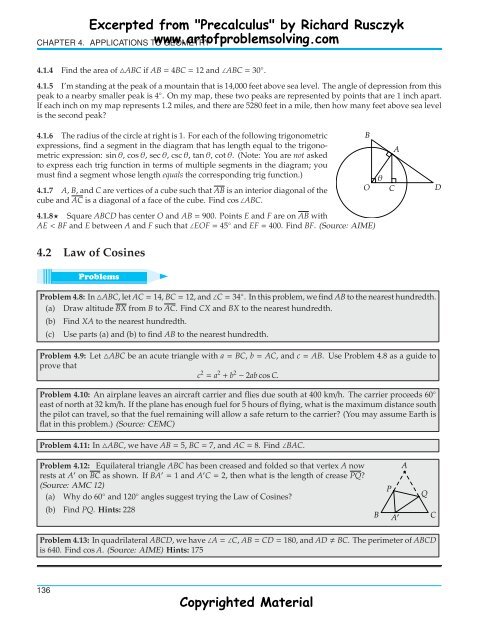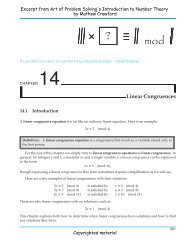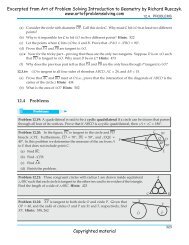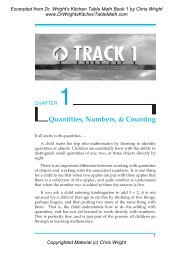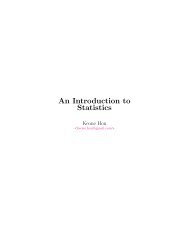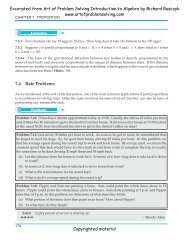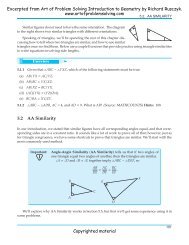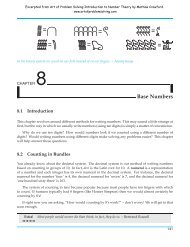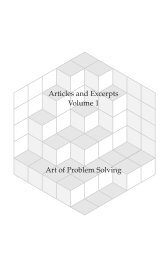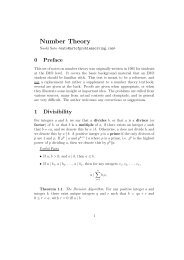Excerpted from "Precalculus" by Richard Rusczyk - Art of Problem ...
Excerpted from "Precalculus" by Richard Rusczyk - Art of Problem ...
Excerpted from "Precalculus" by Richard Rusczyk - Art of Problem ...
Create successful ePaper yourself
Turn your PDF publications into a flip-book with our unique Google optimized e-Paper software.
CHAPTER 4. APPLICATIONS TO GEOMETRY<br />
4.1.4 Find the area <strong>of</strong> △ABC if AB = 4BC = 12 and ∠ABC = 30 ◦ .<br />
4.1.5 I’m standing at the peak <strong>of</strong> a mountain that is 14,000 feet above sea level. The angle <strong>of</strong> depression <strong>from</strong> this<br />
peak to a near<strong>by</strong> smaller peak is 4 ◦ . On my map, these two peaks are represented <strong>by</strong> points that are 1 inch apart.<br />
If each inch on my map represents 1.2 miles, and there are 5280 feet in a mile, then how many feet above sea level<br />
is the second peak?<br />
4.1.6 The radius <strong>of</strong> the circle at right is 1. For each <strong>of</strong> the following trigonometric<br />
expressions, find a segment in the diagram that has length equal to the trigonometric<br />
expression: sin θ, cos θ, sec θ, csc θ, tan θ, cot θ. (Note: You are not asked<br />
to express each trig function in terms <strong>of</strong> multiple segments in the diagram; you<br />
must find a segment whose length equals the corresponding trig function.)<br />
4.1.7 A, B, and C are vertices <strong>of</strong> a cube such that AB is an interior diagonal <strong>of</strong> the<br />
cube and AC is a diagonal <strong>of</strong> a face <strong>of</strong> the cube. Find cos ∠ABC.<br />
4.1.8⋆ Square ABCD has center O and AB = 900. Points E and F are on AB with<br />
AE < BF and E between A and F such that ∠EOF = 45 ◦ and EF = 400. Find BF. (Source: AIME)<br />
4.2 Law <strong>of</strong> Cosines<br />
<strong>Problem</strong>s<br />
<strong>Problem</strong> 4.8: In △ABC, let AC = 14, BC = 12, and ∠C = 34 ◦ . In this problem, we find AB to the nearest hundredth.<br />
(a) Draw altitude BX <strong>from</strong> B to AC. Find CX and BX to the nearest hundredth.<br />
(b) Find XA to the nearest hundredth.<br />
(c) Use parts (a) and (b) to find AB to the nearest hundredth.<br />
<strong>Problem</strong> 4.9: Let △ABC be an acute triangle with a = BC, b = AC, and c = AB. Use <strong>Problem</strong> 4.8 as a guide to<br />
prove that<br />
c 2 = a 2 + b 2 − 2ab cos C.<br />
<strong>Problem</strong> 4.10: An airplane leaves an aircraft carrier and flies due south at 400 km/h. The carrier proceeds 60 ◦<br />
east <strong>of</strong> north at 32 km/h. If the plane has enough fuel for 5 hours <strong>of</strong> flying, what is the maximum distance south<br />
the pilot can travel, so that the fuel remaining will allow a safe return to the carrier? (You may assume Earth is<br />
flat in this problem.) (Source: CEMC)<br />
<strong>Problem</strong> 4.11: In △ABC, we have AB = 5, BC = 7, and AC = 8. Find ∠BAC.<br />
<strong>Problem</strong> 4.12: Equilateral triangle ABC has been creased and folded so that vertex A now<br />
rests at A ′ on BC as shown. If BA ′ = 1 and A ′ C = 2, then what is the length <strong>of</strong> crease PQ?<br />
(Source: AMC 12)<br />
(a) Why do 60 ◦ and 120 ◦ angles suggest trying the Law <strong>of</strong> Cosines?<br />
(b) Find PQ. Hints: 228<br />
B<br />
O<br />
θ<br />
P<br />
C<br />
A<br />
A<br />
Q<br />
B C<br />
A ′<br />
<strong>Problem</strong> 4.13: In quadrilateral ABCD, we have ∠A = ∠C, AB = CD = 180, and AD BC. The perimeter <strong>of</strong> ABCD<br />
is 640. Find cos A. (Source: AIME) Hints: 175<br />
136<br />
<strong>Excerpted</strong> <strong>from</strong> "Precalculus" <strong>by</strong> <strong>Richard</strong> <strong>Rusczyk</strong><br />
www.art<strong>of</strong>problemsolving.com<br />
Copyrighted Material<br />
D
<strong>Problem</strong> 4.8: In △ABC, let AC = 14, BC = 12, and ∠C = 34 ◦ . Find AB to the nearest hundredth.<br />
Solution for <strong>Problem</strong> 4.8: We know how to use trigonometry to find side lengths in right<br />
triangles, so we start <strong>by</strong> drawing an altitude <strong>from</strong> B to AC as shown. This creates right<br />
triangle △BCX with the 34◦ angle as one <strong>of</strong> its acute angles. From right triangle △CBX,<br />
we have<br />
BX<br />
= sin C ≈ 0.559,<br />
BC<br />
4.2. LAW OF COSINES<br />
so BX ≈ 0.559(BC) ≈ 6.71. Similarly, we have CX/BC = cos C ≈ 0.829, so CX ≈ 9.95.<br />
This doesn’t tell us AB yet, but we now have the length <strong>of</strong> one leg <strong>of</strong> △BXA. If we can find the other, we can use<br />
the Pythagorean Theorem to find AB. Fortunately, XA is easy to find: XA = AC − CX ≈ 4.05. Now, we can use the<br />
Pythagorean Theorem to find<br />
<br />
AB = √ BX 2 + XA 2 ≈ 7.84.<br />
In <strong>Problem</strong> 4.8, we were given two side lengths <strong>of</strong> a triangle and the measure <strong>of</strong> the angle between these two<br />
sides. We then found the third side. There was nothing particularly special about the side lengths or the angle.<br />
We might be able to follow essentially the same process for any triangle. Let’s give it a try.<br />
<strong>Problem</strong> 4.9: Let △ABC be an acute triangle with a = BC, b = AC, and c = AB. Find a formula for c in terms <strong>of</strong><br />
a, b, and ∠C.<br />
Solution for <strong>Problem</strong> 4.9: We use <strong>Problem</strong> 4.8 as a guide. In fact, this problem is<br />
essentially the same as <strong>Problem</strong> 4.8, but with variables a, b, and ∠C in place <strong>of</strong> the<br />
numbers that were given in the earlier problem. We can use the same steps. We draw<br />
altitude BX <strong>from</strong> B to AC. Then, we have sin C = BX/BC, so BX = BC sin C = a sin C.<br />
We also have cos C = CX/BC, so CX = BC cos C = a cos C. Therefore, we have<br />
AX = AC − CX = b − a cos C. Next we apply the Pythagorean Theorem to △ABX<br />
to find AB 2 = BX 2 + AX 2 . Substituting our expressions for these three sides gives us<br />
Since sin 2 C + cos 2 C = 1, we have<br />
<br />
<strong>Excerpted</strong> <strong>from</strong> "Precalculus" <strong>by</strong> <strong>Richard</strong> <strong>Rusczyk</strong><br />
www.art<strong>of</strong>problemsolving.com<br />
c 2 = a 2 sin 2 C + (b − a cos C) 2<br />
= a 2 sin 2 C + b 2 − 2ab cos C + a 2 cos 2 C<br />
= a 2 (sin 2 C + cos 2 C) + b 2 − 2ab cos C.<br />
c 2 = a 2 + b 2 − 2ab cos C.<br />
We can test our new formula with the data <strong>from</strong> <strong>Problem</strong> 4.8.<br />
C<br />
C<br />
12<br />
34 ◦<br />
14<br />
b<br />
B<br />
X<br />
B<br />
X<br />
a c<br />
Concept: Once you think you’ve found a new formula, check your work <strong>by</strong> trying the<br />
formula on specific examples you have solved without the formula.<br />
In <strong>Problem</strong> 4.8, we have a = 12, b = 14, and ∠C = 34 ◦ , so we have<br />
c 2 = a 2 + b 2 − 2ab cos C ≈ 61.44.<br />
Taking the square root <strong>of</strong> both sides gives c ≈ 7.84, which agrees with our answer <strong>from</strong> <strong>Problem</strong> 4.8.<br />
With a little more casework (which you’ll supply as an Exercise), we can show that this equation holds for any<br />
triangle ABC.<br />
Copyrighted Material<br />
A<br />
A<br />
137
CHAPTER 4. APPLICATIONS TO GEOMETRY<br />
Important: Let a = BC, b = AC, and c = AB in △ABC. The Law <strong>of</strong> Cosines states that<br />
c 2 = a 2 + b 2 − 2ab cos C.<br />
Notice that when ∠C = 90 ◦ , we have cos C = 0, so the Law <strong>of</strong> Cosines becomes c 2 = a 2 + b 2 , which is just the<br />
Pythagorean Theorem.<br />
<strong>Problem</strong> 4.8 is just a specific example <strong>of</strong> <strong>Problem</strong> 4.9, so we call <strong>Problem</strong> 4.9 a generalization <strong>of</strong> <strong>Problem</strong> 4.8.<br />
Concept: Solving a specific example <strong>of</strong> a general problem can <strong>of</strong>ten provide a guide for<br />
solving the general problem.<br />
<strong>Problem</strong> 4.10: An airplane leaves an aircraft carrier and flies due south at 400 km/h. The carrier proceeds<br />
60 ◦ east <strong>of</strong> north at 32 km/h. If the plane has enough fuel for 5 hours <strong>of</strong> flying, what is the maximum distance<br />
south the pilot can travel, so that the fuel remaining will allow a safe return to the carrier? (You may assume<br />
Earth is flat in this problem.) (Source: CEMC)<br />
Solution for <strong>Problem</strong> 4.10: We start with a diagram, including the path <strong>of</strong> the ship and the path<br />
<strong>of</strong> the plane. The plane leaves the ship at L, flies south to T before turning, and then flies<br />
to S, where it lands on the ship. Because the plane flies south and the ship goes 60 ◦ east <strong>of</strong><br />
north, we have ∠TLS = 180 ◦ − 60 ◦ = 120 ◦ . If the plane flies for 5 hours, then the ship moves<br />
32 · 5 = 160 km and the plane flies 400 · 5 = 2000 km. Therefore, LS = 160 and LT + TS = 2000.<br />
We let the desired distance, LT, be x, so TS = 2000 − x, as shown. We have expressions for all<br />
three sides <strong>of</strong> △LST, and we know one angle, so we apply the Law <strong>of</strong> Cosines:<br />
TS 2 = LT 2 + LS 2 − 2(LT)(LS) cos ∠TLS.<br />
Inserting our expressions and values for lengths and the angle, we have<br />
(2000 − x) 2 = x 2 + 160 2 − 2(x)(160) cos 120 ◦ .<br />
x<br />
L<br />
120◦ T<br />
160<br />
S<br />
2000 − x<br />
We have cos 120 ◦ = − 1<br />
2 (which is one reason the Law <strong>of</strong> Cosines is <strong>of</strong>ten helpful in problems involving 120◦ angles),<br />
and expanding the left side <strong>of</strong> the equation gives<br />
2000 2 − 4000x + x 2 = x 2 + 160 2 + 160x.<br />
Solving this equation gives x ≈ 955, so the plane can fly approximately 955 km south. <br />
<strong>Problem</strong> 4.11: In △ABC, we have AB = 5, BC = 7, and AC = 8. Find ∠BAC.<br />
Solution for <strong>Problem</strong> 4.11: We are given all three side lengths <strong>of</strong> the triangle, so we have all the information in the<br />
Law <strong>of</strong> Cosines except the angle measure. Therefore, we can solve for cos ∠BAC with the Law <strong>of</strong> Cosines. We have<br />
so<br />
BC 2 = AB 2 + AC 2 − 2(AB)(AC) cos ∠BAC,<br />
cos ∠BAC = AB2 + AC 2 − BC 2<br />
2(AB)(AC)<br />
Since 0 ◦ < ∠BAC < 180 ◦ , cos ∠BAC = 1<br />
2 gives us ∠BAC = 60◦ . <br />
138<br />
<strong>Excerpted</strong> <strong>from</strong> "Precalculus" <strong>by</strong> <strong>Richard</strong> <strong>Rusczyk</strong><br />
www.art<strong>of</strong>problemsolving.com<br />
= 25 + 64 − 49<br />
2(5)(8)<br />
= 1<br />
2 .<br />
Concept: The Law <strong>of</strong> Cosines can be used to find angle measures as well as side lengths.<br />
Copyrighted Material
<strong>Problem</strong> 4.12: Equilateral triangle ABC has been creased and folded so that vertex A now<br />
rests at A ′ on BC as shown. If BA ′ = 1 and A ′ C = 2, then what is the length <strong>of</strong> crease PQ?<br />
(Source: AMC 12)<br />
4.2. LAW OF COSINES<br />
P<br />
A<br />
Q<br />
B C<br />
A ′<br />
Solution for <strong>Problem</strong> 4.12: We know that the side length <strong>of</strong> the original equilateral triangle is BA ′ + A ′ C = 3, but<br />
we can’t immediately find any other lengths. So, we assign a variable and hope to express other side lengths in<br />
terms <strong>of</strong> that variable. We might start <strong>by</strong> letting z = PQ, but we don’t see any way to express another side length<br />
in terms <strong>of</strong> z. Therefore, we start <strong>by</strong> letting x = BP, which gives us AP = AB − BP = 3 − x. But now we seem stuck.<br />
Concept: When stuck on a problem, focus on information you haven’t used yet.<br />
We haven’t used the fact that △PA ′ Q is the reflection <strong>of</strong> △PAQ over PQ. This tells us that PA ′ = PA, so<br />
PA ′ = 3 − x. Now, we have expressions for the lengths <strong>of</strong> all three sides <strong>of</strong> △PA ′ B. We also know that ∠PBA ′ = 60 ◦ ,<br />
so we apply the Law <strong>of</strong> Cosines:<br />
so<br />
(PA ′ ) 2 = BP 2 + (BA ′ ) 2 − 2(BP)(BA ′ ) cos ∠PBA ′ ,<br />
(3 − x) 2 = x 2 + 1 − 2x cos 60 ◦ .<br />
Since cos 60 ◦ = 1<br />
2 , we have (3 − x)2 = x 2 − x + 1. Expanding the left side gives 9 − 6x + x 2 = x 2 − x + 1, <strong>from</strong> which<br />
we find x = 8<br />
5<br />
. Therefore, we have BP = 8<br />
5 and PA′ = PA = 3 − BP = 7<br />
5 .<br />
We can do the same thing with AC!<br />
Concept: If a tactic gives some information in a problem, but doesn’t completely solve it,<br />
then try applying that tactic to the problem again in another way.<br />
We let QC = y, so A ′ Q = AQ = 3 − y. Applying the Law <strong>of</strong> Cosines to △A ′ QC gives<br />
so<br />
<strong>Excerpted</strong> <strong>from</strong> "Precalculus" <strong>by</strong> <strong>Richard</strong> <strong>Rusczyk</strong><br />
www.art<strong>of</strong>problemsolving.com<br />
(A ′ Q) 2 = (A ′ C) 2 + QC 2 − 2(A ′ C)(QC) cos ∠A ′ CQ,<br />
(3 − y) 2 = 4 + y 2 − 2(2)(y) cos 60 ◦ .<br />
Solving this equation for y gives us y = 5<br />
5<br />
4 , so QC = 4 and A′ Q = AQ = 3 − QC = 7<br />
4 .<br />
One more time! We have AP = 7 7<br />
5 , AQ = 4 , and ∠PAQ = 60◦ , so we apply the Law <strong>of</strong> Cosines to find<br />
PQ 2 = AP 2 + AQ 2 2 2 <br />
7 7 7 7 1<br />
− 2(AP)(AQ) cos ∠PAQ = + − 2<br />
5 4 5 4 2<br />
Taking the square root gives PQ = 7 √ 21/20. <br />
= 49 49 49 49 · 16 + 49 · 25 − 49 · 20<br />
+ − = =<br />
25 16 20 400<br />
49 · 21<br />
400 .<br />
Each <strong>of</strong> the previous three problems featured a 60◦ or 120◦ angle. Usually, when we see 60◦ or 120◦ , our first<br />
strategy is to look for equilateral triangles or 30-60-90 triangles. But since cos 60◦ = 1<br />
2 and cos 120◦ = − 1<br />
2 , the Law<br />
<strong>of</strong> Cosines has a particularly simple form when the angle is 60◦ or 120◦ .<br />
Copyrighted Material<br />
139
CHAPTER 4. APPLICATIONS TO GEOMETRY<br />
Concept: If a geometry problem contains a 60 ◦ or 120 ◦ angle, you may be able to tackle it<br />
with the Law <strong>of</strong> Cosines.<br />
WARNING!!<br />
j<br />
The Law <strong>of</strong> Cosines can lead to some pretty heavy algebra, so usually we<br />
look for equilateral triangles or 30-60-90 triangles before pulling out the Law<br />
<strong>of</strong> Cosines on a problem that involves 60 ◦ or 120 ◦ angles.<br />
<strong>Problem</strong> 4.13: In quadrilateral ABCD, we have ∠A = ∠C, AB = CD = 180, and AD BC. The perimeter <strong>of</strong><br />
ABCD is 640. Find cos A. (Source: AIME)<br />
Solution for <strong>Problem</strong> 4.13: That the question asks for the cosine <strong>of</strong> an angle suggests that<br />
we either build right triangles or we apply the Law <strong>of</strong> Cosines. But we don’t have any<br />
triangles. So, we make some. The obvious candidate for building triangles is to draw<br />
D<br />
diagonals. We don’t want to draw diagonal AC, since that will break up two angles<br />
C<br />
that we know are equal, and we’ll probably have to use that angle equality. So, we try A B<br />
drawing BD first, there<strong>by</strong> creating two triangles that share a side and have equal angles. We apply the Law <strong>of</strong><br />
Cosines to each, using ∠A in △ABD and ∠C in △CBD:<br />
BD 2 = AB 2 + AD 2 − 2(AB)(AD) cos A,<br />
BD 2 = CB 2 + CD 2 − 2(CB)(CD) cos C.<br />
Setting our two expressions for BD 2 equal, and noting that cos C = cos A because ∠A = ∠C, gives us<br />
AB 2 + AD 2 − 2(AB)(AD) cos A = CB 2 + CD 2 − 2(CB)(CD) cos A.<br />
We also have AB = CD = 180, so AB 2 = CD 2 , and the equation is now<br />
AD 2 − 2(180)(AD) cos A = CB 2 − 2(180)(CB) cos A.<br />
To solve for cos A, we group the cos A terms on the left, and we have<br />
so<br />
2(180)(CB) cos A − 2(180)(AD) cos A = CB 2 − AD 2 ,<br />
cos A =<br />
CB 2 − AD 2<br />
2(180)(CB − AD) .<br />
(This step only avoids dividing <strong>by</strong> 0 because we are told that AD BC. This gives us some confidence that we’re<br />
on the right track.) Factoring the numerator <strong>of</strong> the right side as a difference <strong>of</strong> squares, we have<br />
cos A =<br />
(CB − AD)(CB + AD)<br />
2(180)(CB − AD)<br />
= CB + AD<br />
.<br />
2(180)<br />
Now, we just have to find CB + AD. We go back to the problem, and look for information we haven’t used yet.<br />
We haven’t used the perimeter. That involves the sum <strong>of</strong> sides! Let’s try it. We have AB + CD + CB + AD = 640<br />
and AB = CD = 180, so CB + AD = 640 − 180 − 180 = 280, and we have<br />
<br />
140<br />
<strong>Excerpted</strong> <strong>from</strong> "Precalculus" <strong>by</strong> <strong>Richard</strong> <strong>Rusczyk</strong><br />
www.art<strong>of</strong>problemsolving.com<br />
cos A =<br />
CB + AD<br />
2(180)<br />
280 280 7<br />
= = =<br />
2(180) 360 9 .<br />
Copyrighted Material
<strong>Excerpted</strong> <strong>from</strong> "Precalculus" <strong>by</strong> <strong>Richard</strong> <strong>Rusczyk</strong><br />
www.art<strong>of</strong>problemsolving.com<br />
Exercises<br />
4.2.1 Complete our pro<strong>of</strong> <strong>of</strong> the Law <strong>of</strong> Cosines <strong>by</strong> proving it for obtuse and right triangles.<br />
4.3. LAW OF SINES<br />
4.2.2 Two airplanes take <strong>of</strong>f <strong>from</strong> the same airport at the same time. One flies due west at 200 miles per hour.<br />
The other flies 40 ◦ north <strong>of</strong> due east at 250 miles per hour. To the nearest mile, how many miles apart are the<br />
planes 90 minutes after take<strong>of</strong>f?<br />
4.2.3 Prove each <strong>of</strong> the following:<br />
(a) If AB 2 = BC 2 + CA 2 , then ∠ACB is right.<br />
(b) If AB 2 > BC 2 + CA 2 , then ∠ACB is obtuse.<br />
(c) If AB 2 < BC 2 + CA 2 , then ∠ACB is acute.<br />
In each case, is the converse <strong>of</strong> the given statement true? Why or why not? (The converse <strong>of</strong> a statement <strong>of</strong><br />
the form “If X, then Y” is “If Y, then X.”)<br />
4.2.4 One side <strong>of</strong> a triangle has length twice that <strong>of</strong> another side, and the third side has length 6. If one angle <strong>of</strong><br />
the triangle is 120 ◦ , then what are the possible values <strong>of</strong> the lengths <strong>of</strong> the sides <strong>of</strong> the triangle?<br />
4.2.5 If XY = 3, YZ = 5, and ZX = 7, then what is ∠XYZ?<br />
4.2.6 Quadrilateral ABCD is inscribed in a circle. If AB = 2, BC = 3, CD = 4, and DA = 6, then what is AC?<br />
(Source: CEMC)<br />
4.2.7⋆ Equilateral triangle T is inscribed in circle A, which has radius 10. Circle<br />
B with radius 3 is internally tangent to circle A at one vertex <strong>of</strong> T . Circles C and<br />
D, both with radius 2, are internally tangent to circle A at the other two vertices<br />
<strong>of</strong> T . Circles B, C, and D are all externally tangent to circle E. Find the radius <strong>of</strong><br />
circle E. (Source: AIME)<br />
4.2.8⋆ Triangle ABC has a right angle at B and contains a point P for which<br />
PA = 10, PB = 6, and ∠APB = ∠BPC = ∠CPA. Find PC. (Source: AIME) Hints: 205<br />
4.3 Law <strong>of</strong> Sines<br />
We start with an important fact <strong>from</strong> elementary geometry that will be helpful in this section.<br />
In the diagram at right, we say that ∠BAC is inscribed in arc BC <strong>of</strong> the circle because A, B, and<br />
C are all on the circle. The measure <strong>of</strong> an inscribed angle equals half the measure <strong>of</strong> the arc<br />
it intercepts, so ∠A = BC<br />
2 . If you are not familiar with this relationship, try proving it yourself<br />
before looking it up in a geometry text or online. (This relationship, and many others involving<br />
angles and circles, is covered in <strong>Art</strong> <strong>of</strong> <strong>Problem</strong> Solving’s Introduction to Geometry.)<br />
<strong>Problem</strong>s<br />
A<br />
B<br />
E<br />
C D<br />
A B<br />
<strong>Problem</strong> 4.14: In △PQR, we have PR = 12, ∠QPR = 66 ◦ , and ∠PRQ = 63 ◦ . In this problem, we find PQ and QR.<br />
(a) Let T be the foot <strong>of</strong> the altitude <strong>from</strong> P to QR. Find PT to the nearest hundredth.<br />
(b) Use PT to find PQ to the nearest hundredth.<br />
(c) Find QR to the nearest hundredth.<br />
Copyrighted Material<br />
C<br />
141


